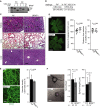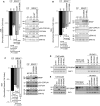RAF dimers control vascular permeability and cytoskeletal rearrangements at endothelial cell-cell junctions
- PMID: 30828992
- PMCID: PMC6617973
- DOI: 10.1111/febs.14802
RAF dimers control vascular permeability and cytoskeletal rearrangements at endothelial cell-cell junctions
Abstract
The endothelium functions as a semipermeable barrier regulating fluid homeostasis, nutrient, and gas supply to the tissue. Endothelial permeability is increased in several pathological conditions including inflammation and tumors; despite its clinical relevance, however, there are no specific therapies preventing vascular leakage. Here, we show that endothelial cell-restricted ablation of BRAF, a kinase frequently activated in cancer, prevents vascular leaking as well metastatic spread. BRAF regulates endothelial permeability by promoting the cytoskeletal rearrangements necessary for the remodeling of VE-Cadherin-containing endothelial cell-cell junctions and the formation of intercellular gaps. BRAF kinase activity and the ability to form complexes with RAS/RAP1 and dimers with its paralog RAF1 are required for proper permeability control, achieved mechanistically by modulating the interaction between RAF1 and the RHO effector ROKα. Thus, RAF dimerization impinges on RHO pathways to regulate cytoskeletal rearrangements, junctional plasticity, and endothelial permeability. The data advocate the development of RAF dimerization inhibitors, which would combine tumor cell autonomous effect with stabilization of the vasculature and antimetastatic spread.
Keywords: RAF kinases; cell-cell adhesions; cytoskeletal rearrangements; vascular permeability.
© 2019 The Authors. The FEBS Journal published by John Wiley & Sons Ltd on behalf of Federation of European Biochemical Societies.
Conflict of interest statement
The authors declare no conflict of interest.
Figures








Comment in
-
BRAF, A gatekeeper controlling endothelial permeability.FEBS J. 2019 Jun;286(12):2273-2276. doi: 10.1111/febs.14861. Epub 2019 May 13. FEBS J. 2019. PMID: 31081213
Similar articles
-
A local VE-cadherin and Trio-based signaling complex stabilizes endothelial junctions through Rac1.J Cell Sci. 2015 Aug 15;128(16):3041-54. doi: 10.1242/jcs.168674. Epub 2015 Jun 26. J Cell Sci. 2015. PMID: 26116572
-
Regulation of vascular endothelial junction stability and remodeling through Rap1-Rasip1 signaling.Cell Adh Migr. 2014;8(2):76-83. doi: 10.4161/cam.28115. Cell Adh Migr. 2014. PMID: 24622510 Free PMC article.
-
Dynamic Regulation of Vascular Permeability by Vascular Endothelial Cadherin-Mediated Endothelial Cell-Cell Junctions.J Nippon Med Sch. 2017;84(4):148-159. doi: 10.1272/jnms.84.148. J Nippon Med Sch. 2017. PMID: 28978894 Review.
-
Rap1 Small GTPase Regulates Vascular Endothelial-Cadherin-Mediated Endothelial Cell-Cell Junctions and Vascular Permeability.Biol Pharm Bull. 2021;44(10):1371-1379. doi: 10.1248/bpb.b21-00504. Biol Pharm Bull. 2021. PMID: 34602545 Review.
-
Angiogenic sprouting requires the fine tuning of endothelial cell cohesion by the Raf-1/Rok-α complex.Dev Cell. 2012 Jan 17;22(1):158-71. doi: 10.1016/j.devcel.2011.11.012. Epub 2011 Dec 29. Dev Cell. 2012. PMID: 22209329 Free PMC article.
Cited by
-
Porphyromonas gingivalis outer membrane vesicles increase vascular permeability by inducing stress fiber formation and degrading vascular endothelial-cadherin in endothelial cells.FEBS J. 2025 Apr;292(7):1696-1709. doi: 10.1111/febs.17349. Epub 2024 Dec 17. FEBS J. 2025. PMID: 39690116 Free PMC article.
-
Exploiting polypharmacology to dissect host kinases and kinase inhibitors that modulate endothelial barrier integrity.Cell Chem Biol. 2021 Dec 16;28(12):1679-1692.e4. doi: 10.1016/j.chembiol.2021.06.004. Epub 2021 Jul 2. Cell Chem Biol. 2021. PMID: 34216546 Free PMC article.
-
BRAF Modulates Stretch-Induced Intercellular Gap Formation through Localized Actin Reorganization.Int J Mol Sci. 2021 Aug 20;22(16):8989. doi: 10.3390/ijms22168989. Int J Mol Sci. 2021. PMID: 34445693 Free PMC article.
-
Metformin alleviates lung-endothelial hyperpermeability by regulating cofilin-1/PP2AC pathway.Front Pharmacol. 2023 Jun 8;14:1211460. doi: 10.3389/fphar.2023.1211460. eCollection 2023. Front Pharmacol. 2023. PMID: 37361221 Free PMC article.
-
Rho-Proteins and Downstream Pathways as Potential Targets in Sepsis and Septic Shock: What Have We Learned from Basic Research.Cells. 2021 Jul 21;10(8):1844. doi: 10.3390/cells10081844. Cells. 2021. PMID: 34440613 Free PMC article. Review.
References
-
- Trani M & Dejana E (2015) New insights in the control of vascular permeability: vascular endothelial‐cadherin and other players. Curr Opin Hematol 22, 267–272. - PubMed
-
- Kreuger J & Phillipson M (2016) Targeting vascular and leukocyte communication in angiogenesis, inflammation and fibrosis. Nat Rev Drug Discov 15, 125–142. - PubMed
-
- Nguyen DX, Bos PD & Massague J (2009) Metastasis: from dissemination to organ‐specific colonization. Nat Rev Cancer 9, 274–284. - PubMed
Publication types
MeSH terms
Substances
Grants and funding
LinkOut - more resources
Full Text Sources
Molecular Biology Databases
Research Materials
Miscellaneous

